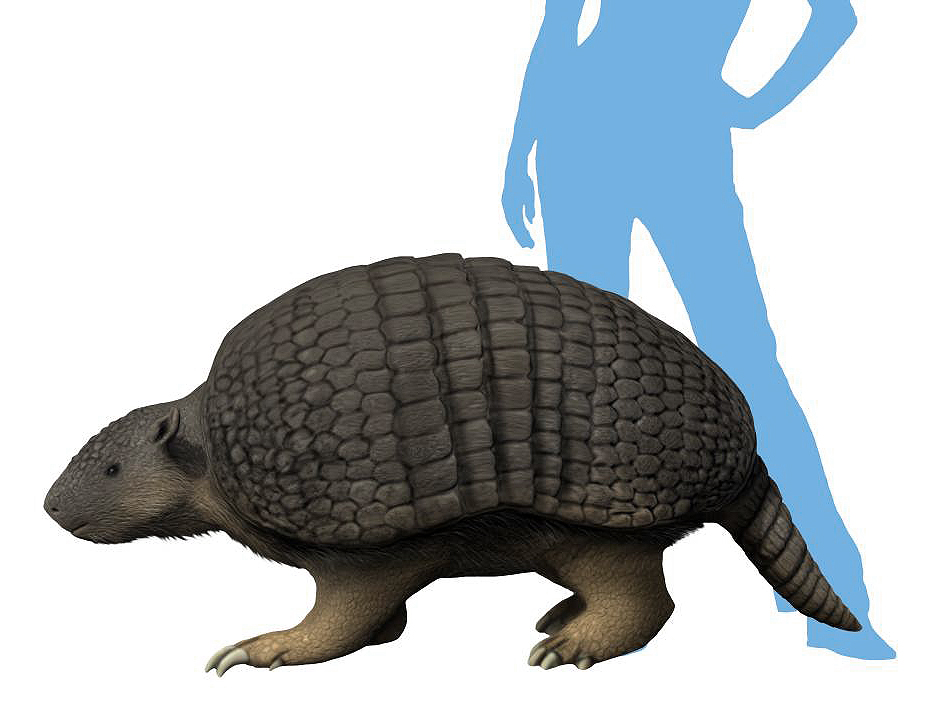Holmesina on:
[Wikipedia]
[Google]
[Amazon]
''Holmesina'' is a genus of 
 ''Holmesina'' individuals were much larger than any modern armadillo: They could reach a length of , and a weight of , while the modern
''Holmesina'' individuals were much larger than any modern armadillo: They could reach a length of , and a weight of , while the modern
pampathere
Pampatheriidae ("Pampas beasts") is an extinct family of large plantigrade armored armadillos related to extant armadillos in the order Cingulata. However, pampatheriids have existed as a separate lineage since at least the middle Eocene Mus ...
, an extinct
Extinction is the termination of a kind of organism or of a group of kinds (taxon), usually a species. The moment of extinction is generally considered to be the death of the last individual of the species, although the capacity to breed and ...
group of armadillo
Armadillos (meaning "little armored ones" in Spanish) are New World placental mammals in the order Cingulata. The Chlamyphoridae and Dasypodidae are the only surviving families in the order, which is part of the superorder Xenarthra, along wi ...
-like creatures that were distantly related to extant
Extant is the opposite of the word extinct. It may refer to:
* Extant hereditary titles
* Extant literature, surviving literature, such as ''Beowulf'', the oldest extant manuscript written in English
* Extant taxon, a taxon which is not extinct, ...
armadillos. Like armadillos, and unlike the other extinct branch of megafaunal cingulates, the glyptodonts
Glyptodonts are an extinct subfamily of large, heavily armoured armadillos. They arose in South America around 48 million years ago and spread to southern North America after the continents became connected several million years ago. The best-kn ...
, the shell was made up of flexible plates which allowed the animal to move more easily. ''Holmesina'' species were herbivores
A herbivore is an animal anatomically and physiologically adapted to eating plant material, for example foliage or marine algae, for the main component of its diet. As a result of their plant diet, herbivorous animals typically have mouthpart ...
that grazed on coarse vegetation; armadillos are mostly insectivorous
A robber fly eating a hoverfly
An insectivore is a carnivorous animal or plant that eats insects. An alternative term is entomophage, which can also refer to the human practice of eating insects.
The first vertebrate insectivores were ...
or omnivorous
An omnivore () is an animal that has the ability to eat and survive on both plant and animal matter. Obtaining energy and nutrients from plant and animal matter, omnivores digest carbohydrates, protein, fat, and fiber, and metabolize the nutri ...
.

 ''Holmesina'' individuals were much larger than any modern armadillo: They could reach a length of , and a weight of , while the modern
''Holmesina'' individuals were much larger than any modern armadillo: They could reach a length of , and a weight of , while the modern giant armadillo
The giant armadillo (''Priodontes maximus''), colloquially ''tatu-canastra'', ''tatou'', ''ocarro'' or ''tatú carreta'', is the largest living species of armadillo (although their extinct relatives, the Glyptodontidae, glyptodonts, were much l ...
does not attain more than .
Distribution
They traveled north during the faunal interchange, and adapted well toNorth America
North America is a continent in the Northern Hemisphere and almost entirely within the Western Hemisphere. It is bordered to the north by the Arctic Ocean, to the east by the Atlantic Ocean, to the southeast by South America and the Car ...
, like the ground sloth
Ground sloths are a diverse group of extinct sloths in the mammalian superorder Xenarthra. The term is used to refer to all extinct sloths because of the large size of the earliest forms discovered, compared to existing tree sloths. The Caribbe ...
s, glyptodonts, armadillos, capybara
The capybaraAlso called capivara (in Brazil), capiguara (in Bolivia), chigüire, chigüiro, or fercho (in Colombia and Venezuela), carpincho (in Argentina, Paraguay and Uruguay) and ronsoco (in Peru). or greater capybara (''Hydrochoerus hydro ...
s, and other South American
South America is a continent entirely in the Western Hemisphere and mostly in the Southern Hemisphere, with a relatively small portion in the Northern Hemisphere at the northern tip of the continent. It can also be described as the southe ...
immigrants. Their fossils are found from Brazil to the United States, mostly in Texas
Texas (, ; Spanish language, Spanish: ''Texas'', ''Tejas'') is a state in the South Central United States, South Central region of the United States. At 268,596 square miles (695,662 km2), and with more than 29.1 million residents in 2 ...
and Florida
Florida is a state located in the Southeastern region of the United States. Florida is bordered to the west by the Gulf of Mexico, to the northwest by Alabama, to the north by Georgia, to the east by the Bahamas and Atlantic Ocean, and to ...
.
References
Further reading
* J. C. Cisneros. 2005. New Pleistocene vertebrate fauna from El Salvador. Revista Brasileira de Paleontologia 8(3):239-255 * P. J. Gaudioso, G. M. Gasparini, and R. M. Barquez. 2016. Paleofauna del Pleistoceno de Termas de Rio Hondo, Santiago del Estero, Argentina. Ameghiniana 53(6):54-54 * J. I. Mead, S. L. Swift, R. S. White, H. G. McDonald, and A. Baez. 2007. Late Pleistocene (Rancholabrean) glyptodont and pampathere (Xenarthra, Cingulata) from Sonora, Mexico. Revista Mexicana de Ciencias Geológicas 24(3):439-449 {{Taxonbar, from=Q140865 Prehistoric cingulates Pleistocene xenarthrans Prehistoric placental genera Pleistocene mammals of North America Blancan Rancholabrean Pleistocene Costa Rica Fossils of Costa Rica Pleistocene El Salvador Fossils of El Salvador Pleistocene Mexico Fossils of Mexico Pleistocene United States Pleistocene mammals of South America Lujanian Ensenadan Uquian Pleistocene Argentina Fossils of Argentina Pleistocene Brazil Fossils of Brazil Pleistocene Ecuador Fossils of Ecuador Pleistocene Peru Fossils of Peru Pleistocene Venezuela Fossils of Venezuela Fossil taxa described in 1930 Taxa named by George Gaylord Simpson